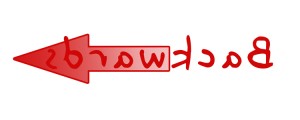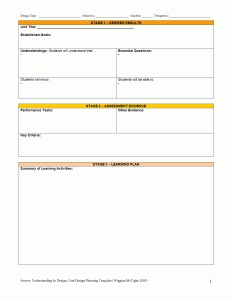Backward Design (Scholar Post)
A topic that I found interesting during our semester together was that of backward design. Teaching has evolved dramatically over the past few decades. It is becoming less about just “teaching” a subject, and more about making sure that your students understand what they are being taught, and why it is important to them when they graduate. This is largely due to more state and national standardized testing that students are required to take. Because of this, teachers are finding it difficult to plan for their classes. They want to make sure that students are getting the most out of what they’re required to learn.
We were first introduced to the idea of backward design in class during module 6 (class 4/13). I have heard about this approach in other classes, but I was learning about what it entailed. Now planning is going beyond just knowing what you’re teaching or what the state standards are for your subject. Now you need to know the knowledge of your students (Graff 2011). This is where we start to look at a great concept called curricular knowledge.
Curricular knowledge has two main parts. The first being horizontal, and the second is vertical. Graff does a great job at explaining these two types of knowledge. Horizontal entails the materials that students are studying in other classes, at the same time as your own. Vertical knowledge is the familiarity of what the students have already learned in your subject area, or what they are going to learn down the road (Graff 2011). Why is this important? Because to teach your students effectively you HAVE to understand what they already know, and what they don’t know. So after you have an understanding of where your students are, you can start to lesson plan. Backwards designing is just what it means, backwards planning. Where should a teacher start when creating a lesson plan that is backward?
The end goal of a backward design curriculum and instruction is for students to have a deeper understanding of what they’re learning along with retention and generalization (Chidre 2009). To ensure that this happens the way we would like it to there are specific steps that should be followed They include Identifying learners, identifying curricular priorities, design assessment framework, and create learning activities (Childre 2009).
Identifying learners is important for many reasons, but for your students to gain the most out of your class you need to understand their learning pattern. Do any of your students require special needs? Are any of your student’s ESL or ELL learners? After you have identified the learners individually it is important to identify your classroom needs as well. Are you more of a discussion based class? Or do you really like to lecture, and have the students note take? After you have assessed the learners you can move on to priorities.
Identifying curricular priorities is the second step. Here is where you will look at your state, and local standards. What is the knowledge that the children are supposed to gain out of your class by the end of the lesson? Other things that you could look at include are what your students should already know by the time they reach your classroom?
The third step is designing assessment framework. How are you going to get your students to learn what you want them to know? Childre (2009), explains “The aim is to move beyond recall of memorized facts to deeper understanding” (pg 9). This step helps you figure out how you want to test your students to make sure that they are gaining the knowledge you want them too. Will you quiz them? Have tests, or writing projects? The things you can do are really, endless. Once you have figured out you can get to the fun part, planning!
Step four is the part where you get to plan the activities for your students. This can be a fun, yet intimidating. Here I will bring in the template that we used in class.
As you can see, the template that we used in class really helps us get to the result we want for our students (class 4/13). The first thing that it asks the teacher to do is step one, which is the desired results. What are your goals? What do you want students to take away from your class? Then it goes into the understandings of the students. What do they already know? What do you want them to know? The second part of the lesson plan template allows you to plan for assessment. What will you have students do to show that they are learning the important information? What are other ways besides exams or projects that could show evidence? What criteria will the students be judged on? Lastly, you can use the large space to plan activities. These could include field trips, guided notes, and other fun activities to make the topic at hand interesting to learn. Along with this template, Wiggins (2012) does an awesome job at explaining why backward design is important in classrooms by having teachers continue to go back to their essential question, and make sure that they’re staying on track. He also has some great videos about creating a fantastic design for your classroom. Remember, Wiggins and McTighe (2005) explain that students are innocent of learning until they are proven “guilty” by the evidence the teacher uses.
In the end, I feel that backward design is one of the most effective ways to lesson plan. I really like starting with your goals, and explaining how you’ll get to them. Attached I have a video that does a really great job of showing why backward design can be important for every student!
References:
Childre, A., Sands, J. R., & Pope, S. T. (2009). Backward Design. Teaching Exceptional Children, 41(5), 6-14.
Graff, N. (2011). “An Effective and Agonizing Way to Learn”: Backwards Design and New Teachers’ Preparation for Planning Curriculum. Teacher Education Quarterly, 38(3), 151-168.
Wiggins, G., & McTighe, Jay. (2005). Understanding by design / Grant Wiggins and Jay McTighe. (Expanded 2nd ed.).
Wiggins Video: https://www.youtube.com/watch?v=WsDgfC3SjhM
Filed under Uncategorized | Comments (6)
6 Responses to “Backward Design (Scholar Post)”


Hеllo! Sοmeone in my Facebook grroup sһared this website with us soo I came to tske a look.
I’m definitewⅼy enjoing the information. I’m bookmarkіng annd will be tweeting
this to my followers! Excellent blog and terrific ԁesign.
thanks you
http://mpsi.uma.ac.id/
https://drawnbyhislight.com
I think that backward design is a very good idea. It is important to design things in such a way that they are easy to use, but also difficult to misuse. The reason for this is simple: If a person can misuse something easily, then there is no need for them to learn how it works. Thanksgiving templates from https://masterbundles.com/templates/presentations/powerpoint/thanksgiving/ source are really good. This will result in more people being able to use the product correctly and effectively.
We require official test scores from either the ACT or SAT depending on which test you take. If you took both tests and sat for both exams separately, we require only one score from each exam and we prefer you this https://bestonlinewritingservice.com/ site to get prepared for the next exams easily. We will not consider scores from previous years unless they are reported on a transcript by a school representative or tutor (we will accept high school equivalency testing results).
Your suggested topic inspired me a lot in fact i would like to say thanks for the delivery of this quality content. Make sure you will be share more blogs Top Gun Jackets like this.